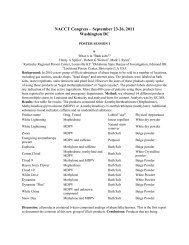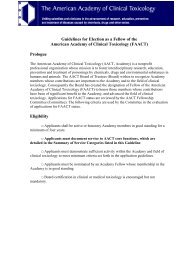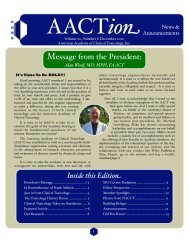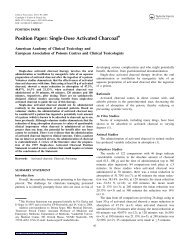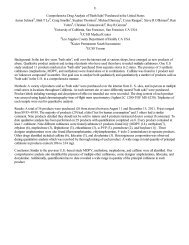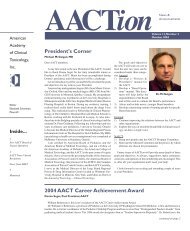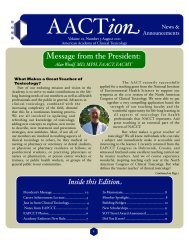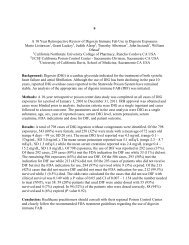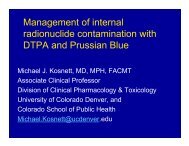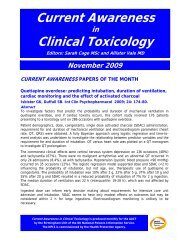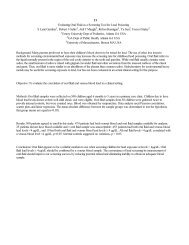Posters IV - The American Academy of Clinical Toxicology
Posters IV - The American Academy of Clinical Toxicology
Posters IV - The American Academy of Clinical Toxicology
Create successful ePaper yourself
Turn your PDF publications into a flip-book with our unique Google optimized e-Paper software.
More education is needed among emergency physicians <strong>of</strong> all ages and levels <strong>of</strong> training on synthetic<br />
cannabinoids.<br />
283<br />
Pills vs. Candy: A Popular Online Game to Prevent Poisonings<br />
Iana M Simeonov 1 , Kristina M Hamm 1 , Stuart E Heard 1<br />
1 UCSF-California Poison Control System, San Francisco CA USA<br />
Background Poison exposure is the 2nd leading cause <strong>of</strong> injury and death to children 0-5 years in the<br />
U.S. Nationally, nearly 80% <strong>of</strong> poison exposures occur at home and 51% involve children under 5.<br />
However, parents are largely unaware <strong>of</strong> poisoning risks, <strong>of</strong>ten confused about prevention strategies and<br />
unacquainted with poison centers as a resource. Data from the <strong>American</strong> Association <strong>of</strong> Poison Control<br />
Centers shows OTC and prescription medications accounting for the majority <strong>of</strong> childhood exposures. In<br />
focus groups, parents report concern around colorful "pills" being mistaken for treats. Objective In 2010,<br />
online games overtook personal email to become the 2nd biggest activity behind social networks. To<br />
leverage the popularity <strong>of</strong> games for health promotion, "Pills vs. Candy" was developed and launched<br />
within three weeks. <strong>The</strong> game delivers a simple message: over-the-counter medications and candy may<br />
appear indistinguishable and pose a risk to children. Methods Players identify seemingly identical pairs<br />
<strong>of</strong> medicine and candy by tapping on a photo. Answers are shown with the next pairing, player scores are<br />
tabulated and can be posted on Facebook or Twitter. OTC medications and candy were photographed<br />
pr<strong>of</strong>essionally, a designer created a simple, clean user interface and a developer custom-coded the game<br />
using the programming language PHP. <strong>The</strong> game has its own .com and .org web addresses for English and<br />
Spanish versions. Results In its first 2 months, the game had 12,000 visits. Most visitors played to the end<br />
and scored 65% correct. <strong>The</strong> initial "bounce rate" (percentage who did not continue) was a low 22%. At<br />
first, most traffic was direct, but promotion efforts have increased the number <strong>of</strong> visitors referred from<br />
other sites by 200%. Most recent data shows 409 visits in March 2011 alone, a lowered bounce rate <strong>of</strong><br />
14%, and a 61% increase in referring traffic. Media mentions <strong>of</strong> the service also increased by nearly 30%.<br />
Conclusions As part <strong>of</strong> a social marketing strategy, online and social games have enormous potential to<br />
deliver serious messages. For budget-conscious public health programs, they can also be a cost-effective<br />
way to reach larger audiences.<br />
284<br />
A Risky Toy<br />
S. Denise Holzman 1 , Andrea Clements 1 , Keith Boesen 1 , Farshad Shirazi 1<br />
1 Arizona Poison and Drug Information Center, University <strong>of</strong> Arizona, Tucson AZ USA<br />
Background: Rare earth magnets have powerful properties, such as strong magnetic field and great<br />
resistance to demagnetization. <strong>The</strong>se attributes result in compact, light magnets, and make them desirable<br />
for use in many products. <strong>The</strong>y have also been incorporated into toys. <strong>The</strong> same properties that make these<br />
magnets valuable in other applications make them hazardous if ingested. Cases <strong>of</strong> potentially lifethreatening<br />
effects as a result <strong>of</strong> magnet ingestions have been reported. Case report: We present a 3 year<br />
old who swallowed 13 rare earth magnets. <strong>The</strong> magnets, called Buckyballs, were 5 mm each, spherical<br />
and smooth. An initial x-ray showed 2 foreign bodies located near his epiglottis and 11 foreign bodies,<br />
linked together in a linear fashion, located near the upper portion <strong>of</strong> his small intestine. <strong>The</strong> 2 magnets in<br />
the upper oropharynx were removed. For three days he received MiraLax 17 grams twice daily, and for<br />
two days he was given a sodium phosphate/biphosphate pediatric enema, 66 milliliters (mL) per dose. X-



